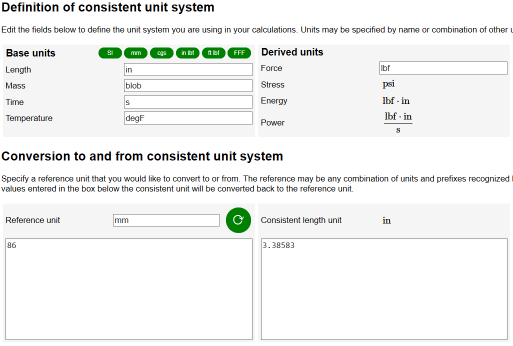How Do You Get Your FEA Units Consistent?
Unit choice and consistency is a topic that’s very near to a lot of engineers’ hearts. We tend to have strong opinions about other people’s differing opinions on it, and when we find unit mistakes, they can be some of the most spectacular screw-ups in engineering history. So how do we avoid embarrassing unit mismatches and surprise dimensional analysis? With handy reference and clever calculator tools:
Getting Consistent Units: A Helpful Table
Abaqus has no built-in system of units. Therefore, before starting to define any model, we have to decide which system of units will be used. For the analysis results to be accurate or meaningful, all input data must be specified in consistent units. A system is consistent when the derived units (force, stress, energy, power) are correctly expressed in terms of the chosen base units (length, mass, time, temperature). Some common systems of consistent units are shown in the table below (source in manual).
| Quantity | SI | SI (mm) | US Unit (ft) | US Unit (inch) |
|---|---|---|---|---|
| Length | m | mm | ft | in |
| Force | N | N | lbf | lbf |
| Mass | kg | tonne (103 kg) | slug | lbf s2/in |
| Time | s | s | s | s |
| Stress | Pa (N/m2) | MPa (N/mm2) | lbf/ft2 | psi (lbf/in2) |
| Energy | J | mJ (10−3 J) | ft lbf | in lbf |
| Density | kg/m3 | tonne/mm3 | slug/ft3 | lbf s2/in4 |
Table 1. Common consistent unit systems
Inch Issues: Blob? Slinch? Slugette? Snail?
Working in US (inch) units can be a real headache, and two of the most confusing properties are mass and density. Mass and density are often given in the form of lbm and lbm/in3, respectively, and therefore must be converted to the form of lbf s2/in and lbf s2/in4.
Here are the conversion formulae:
Figure 1: Mass conversion: lbm to lbf s2/in
Figure 2: Density conversion: lbm/in3 to lbf s2/in4
Just Give Me Quick Conversions!
 Our technical manager, Carl Osterwisch, has created a very useful FEA unit conversion tool. It will take your base units of choice (length, mass, time, and temperature) and give you consistent derived units (force, stress, energy, and power). The calculator will also take units of any system and convert them into your system. Extremely handy.
Our technical manager, Carl Osterwisch, has created a very useful FEA unit conversion tool. It will take your base units of choice (length, mass, time, and temperature) and give you consistent derived units (force, stress, energy, and power). The calculator will also take units of any system and convert them into your system. Extremely handy.

 Blog
Blog